Case Study on Multiple Sclerosis: Risk Factors, Aetiology, and Nursing Interventions
VerifiedAdded on 2023/06/10
|11
|3436
|202
AI Summary
This case study discusses a patient with multiple sclerosis and evaluates her risk factors and aetiology. It covers the symptoms, diagnosis, and treatment options for the disease. The nursing interventions and diagnostic steps are also discussed.
Contribute Materials
Your contribution can guide someone’s learning journey. Share your
documents today.

Running head- CASE STUDY
Assessment Task 1
Name of the Student
Name of the University
Author Note
Assessment Task 1
Name of the Student
Name of the University
Author Note
Secure Best Marks with AI Grader
Need help grading? Try our AI Grader for instant feedback on your assignments.

1CASE STUDY
Multiple sclerosis (MS) refers to a neurological condition that is potentially disabling
and affects the brain and the spinal cord. In MS, the host’s immune system attack the
shielding myelin or medullary sheath that is found to cover the nerve fibres facilitate
communication between the brain and entire body. Eventually, the neurological disease can
results in a deterioration of the nerves that become permanently damaged. The common signs
and symptoms of this condition vary extensively and are subjected to the extent of nerve
damage and the specific nerves that are affected. Some of the most common manifestations
of MS encompass weakness and numbness in one or both limbs that are found to typically
occur at one part of the body (Lublin et al. 2014). Complete or partial loss of vision is also
found among the patients, in addition to pain and tingling sensation in different parts of the
body. Furthermore, most patients suffering from MS report relapses in their health condition
and experience newer symptoms that last over several weeks and days, and usually get
improved completely or partially. This assignment will discuss a case study of a MS patient
and will critically evaluate her risk factors and aetiology with the presenting complaints.
MS is identified as one of the most common neurological disease that affects more
than a million individuals on a global scale. The disease usually begins in adult life (20-
45years) and results in a progressive disability among people in several decades.
Furthermore, it is more common in females than males, in the ratio 2:1 (MyVMC 2018). The
prevalence of the disorder is considered directly proportional to the distance of the affected
people from the equator. The prevalence is an estimated 60-100/100,000 person at 50-65
degrees latitude and is rarely found at the Equator. There were an estimated 23,700
Australians with MS in the year 2009, and of them 48% or 11, 400 suffered from severe
forms of the condition (Abs.gov.au 2018).
The patient X (pseudonym), aged 40 years had been first diagnosed with MS in the
year 2014. She had recently given birth to a child and was a breastfeeding mother. Some of
Multiple sclerosis (MS) refers to a neurological condition that is potentially disabling
and affects the brain and the spinal cord. In MS, the host’s immune system attack the
shielding myelin or medullary sheath that is found to cover the nerve fibres facilitate
communication between the brain and entire body. Eventually, the neurological disease can
results in a deterioration of the nerves that become permanently damaged. The common signs
and symptoms of this condition vary extensively and are subjected to the extent of nerve
damage and the specific nerves that are affected. Some of the most common manifestations
of MS encompass weakness and numbness in one or both limbs that are found to typically
occur at one part of the body (Lublin et al. 2014). Complete or partial loss of vision is also
found among the patients, in addition to pain and tingling sensation in different parts of the
body. Furthermore, most patients suffering from MS report relapses in their health condition
and experience newer symptoms that last over several weeks and days, and usually get
improved completely or partially. This assignment will discuss a case study of a MS patient
and will critically evaluate her risk factors and aetiology with the presenting complaints.
MS is identified as one of the most common neurological disease that affects more
than a million individuals on a global scale. The disease usually begins in adult life (20-
45years) and results in a progressive disability among people in several decades.
Furthermore, it is more common in females than males, in the ratio 2:1 (MyVMC 2018). The
prevalence of the disorder is considered directly proportional to the distance of the affected
people from the equator. The prevalence is an estimated 60-100/100,000 person at 50-65
degrees latitude and is rarely found at the Equator. There were an estimated 23,700
Australians with MS in the year 2009, and of them 48% or 11, 400 suffered from severe
forms of the condition (Abs.gov.au 2018).
The patient X (pseudonym), aged 40 years had been first diagnosed with MS in the
year 2014. She had recently given birth to a child and was a breastfeeding mother. Some of
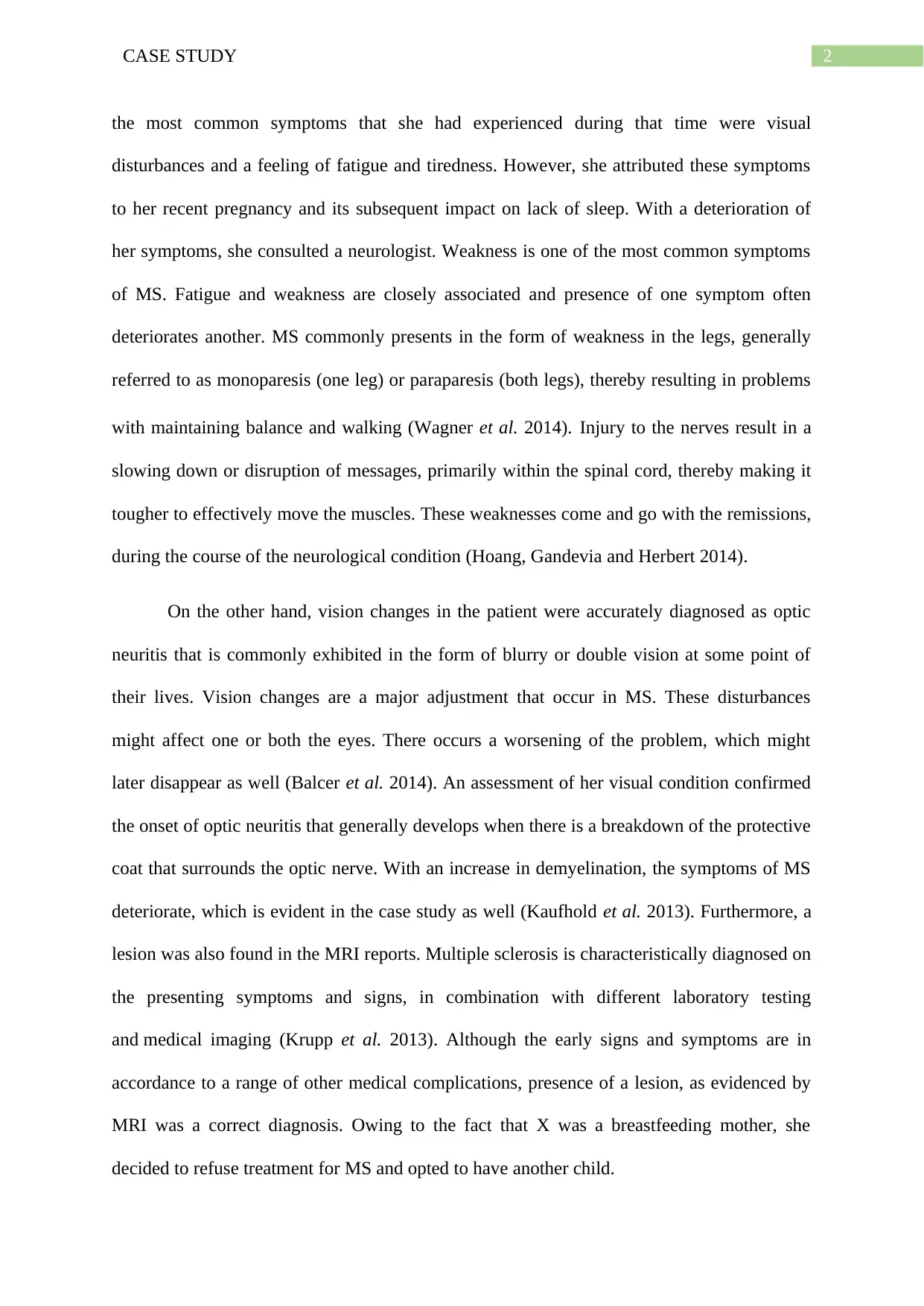
2CASE STUDY
the most common symptoms that she had experienced during that time were visual
disturbances and a feeling of fatigue and tiredness. However, she attributed these symptoms
to her recent pregnancy and its subsequent impact on lack of sleep. With a deterioration of
her symptoms, she consulted a neurologist. Weakness is one of the most common symptoms
of MS. Fatigue and weakness are closely associated and presence of one symptom often
deteriorates another. MS commonly presents in the form of weakness in the legs, generally
referred to as monoparesis (one leg) or paraparesis (both legs), thereby resulting in problems
with maintaining balance and walking (Wagner et al. 2014). Injury to the nerves result in a
slowing down or disruption of messages, primarily within the spinal cord, thereby making it
tougher to effectively move the muscles. These weaknesses come and go with the remissions,
during the course of the neurological condition (Hoang, Gandevia and Herbert 2014).
On the other hand, vision changes in the patient were accurately diagnosed as optic
neuritis that is commonly exhibited in the form of blurry or double vision at some point of
their lives. Vision changes are a major adjustment that occur in MS. These disturbances
might affect one or both the eyes. There occurs a worsening of the problem, which might
later disappear as well (Balcer et al. 2014). An assessment of her visual condition confirmed
the onset of optic neuritis that generally develops when there is a breakdown of the protective
coat that surrounds the optic nerve. With an increase in demyelination, the symptoms of MS
deteriorate, which is evident in the case study as well (Kaufhold et al. 2013). Furthermore, a
lesion was also found in the MRI reports. Multiple sclerosis is characteristically diagnosed on
the presenting symptoms and signs, in combination with different laboratory testing
and medical imaging (Krupp et al. 2013). Although the early signs and symptoms are in
accordance to a range of other medical complications, presence of a lesion, as evidenced by
MRI was a correct diagnosis. Owing to the fact that X was a breastfeeding mother, she
decided to refuse treatment for MS and opted to have another child.
the most common symptoms that she had experienced during that time were visual
disturbances and a feeling of fatigue and tiredness. However, she attributed these symptoms
to her recent pregnancy and its subsequent impact on lack of sleep. With a deterioration of
her symptoms, she consulted a neurologist. Weakness is one of the most common symptoms
of MS. Fatigue and weakness are closely associated and presence of one symptom often
deteriorates another. MS commonly presents in the form of weakness in the legs, generally
referred to as monoparesis (one leg) or paraparesis (both legs), thereby resulting in problems
with maintaining balance and walking (Wagner et al. 2014). Injury to the nerves result in a
slowing down or disruption of messages, primarily within the spinal cord, thereby making it
tougher to effectively move the muscles. These weaknesses come and go with the remissions,
during the course of the neurological condition (Hoang, Gandevia and Herbert 2014).
On the other hand, vision changes in the patient were accurately diagnosed as optic
neuritis that is commonly exhibited in the form of blurry or double vision at some point of
their lives. Vision changes are a major adjustment that occur in MS. These disturbances
might affect one or both the eyes. There occurs a worsening of the problem, which might
later disappear as well (Balcer et al. 2014). An assessment of her visual condition confirmed
the onset of optic neuritis that generally develops when there is a breakdown of the protective
coat that surrounds the optic nerve. With an increase in demyelination, the symptoms of MS
deteriorate, which is evident in the case study as well (Kaufhold et al. 2013). Furthermore, a
lesion was also found in the MRI reports. Multiple sclerosis is characteristically diagnosed on
the presenting symptoms and signs, in combination with different laboratory testing
and medical imaging (Krupp et al. 2013). Although the early signs and symptoms are in
accordance to a range of other medical complications, presence of a lesion, as evidenced by
MRI was a correct diagnosis. Owing to the fact that X was a breastfeeding mother, she
decided to refuse treatment for MS and opted to have another child.

3CASE STUDY
The pathophysiology of MS comprises of three major component namely, a lesion in
the CNS, inflammation and destruction of the medullary sheath that surrounds the neurons.
Plaques or lesions commonly affect the basal ganglia, optic nerve white matter and the spinal
cord, in addition to the white matter regions present near the lateral ventricles. Progressive
loss of oligodendrocytes that are responsible for maintaining and creating a layer of fatty
tissue, leads to complete or partial loss of myelin with an advancement of the disease (Solaro,
Trabucco and Uccelli 2013). With a loss of myelin sheath, the neurons fail to effectively
transmit nerve signals. Attack of the myelin sheath begins the inflammatory process that
leads to the release of cytokines and several antibodies. Breakdown of the blood-brain barrier
also leads to a plethora of other detrimental effects such as, activation of macrophage,
swelling, and activation of cytokines.
Following breastfeeding the second child for few months, she began the treatment and
was under the administration of Tysabri infusion of 300mg, IV, for every 28 days. Tysabri or
natalizumab is a prescription medicine, commonly used for treating adults with relapsing
multiple sclerosis, and helps in slowing down the rate of worsening of indications and
reducing the number of relapses or flare-ups. Research evidences have established the role of
the medication in reducing the progression of the neurological disability among patients
(Butzkueven et al. 2014). Furthermore, when used in combination with IB1A, reduction of
visual loss, increase in number of MS free patients and enhanced assessments of their health
associated quality of life have also been observed (Kamm, Uitdehaag and Polman 2014).
Further advantages of Tysabri are associated with a reduction in cognitive decline among
individuals with MS, with subsequent reduction in rates of hospitalizations and use of
steroids.
Furthermore, the drug is also approved in the European nation and the US to be used
in the form of monotherapy, with the aim of treating active and relapsing MS, despite
The pathophysiology of MS comprises of three major component namely, a lesion in
the CNS, inflammation and destruction of the medullary sheath that surrounds the neurons.
Plaques or lesions commonly affect the basal ganglia, optic nerve white matter and the spinal
cord, in addition to the white matter regions present near the lateral ventricles. Progressive
loss of oligodendrocytes that are responsible for maintaining and creating a layer of fatty
tissue, leads to complete or partial loss of myelin with an advancement of the disease (Solaro,
Trabucco and Uccelli 2013). With a loss of myelin sheath, the neurons fail to effectively
transmit nerve signals. Attack of the myelin sheath begins the inflammatory process that
leads to the release of cytokines and several antibodies. Breakdown of the blood-brain barrier
also leads to a plethora of other detrimental effects such as, activation of macrophage,
swelling, and activation of cytokines.
Following breastfeeding the second child for few months, she began the treatment and
was under the administration of Tysabri infusion of 300mg, IV, for every 28 days. Tysabri or
natalizumab is a prescription medicine, commonly used for treating adults with relapsing
multiple sclerosis, and helps in slowing down the rate of worsening of indications and
reducing the number of relapses or flare-ups. Research evidences have established the role of
the medication in reducing the progression of the neurological disability among patients
(Butzkueven et al. 2014). Furthermore, when used in combination with IB1A, reduction of
visual loss, increase in number of MS free patients and enhanced assessments of their health
associated quality of life have also been observed (Kamm, Uitdehaag and Polman 2014).
Further advantages of Tysabri are associated with a reduction in cognitive decline among
individuals with MS, with subsequent reduction in rates of hospitalizations and use of
steroids.
Furthermore, the drug is also approved in the European nation and the US to be used
in the form of monotherapy, with the aim of treating active and relapsing MS, despite
Secure Best Marks with AI Grader
Need help grading? Try our AI Grader for instant feedback on your assignments.
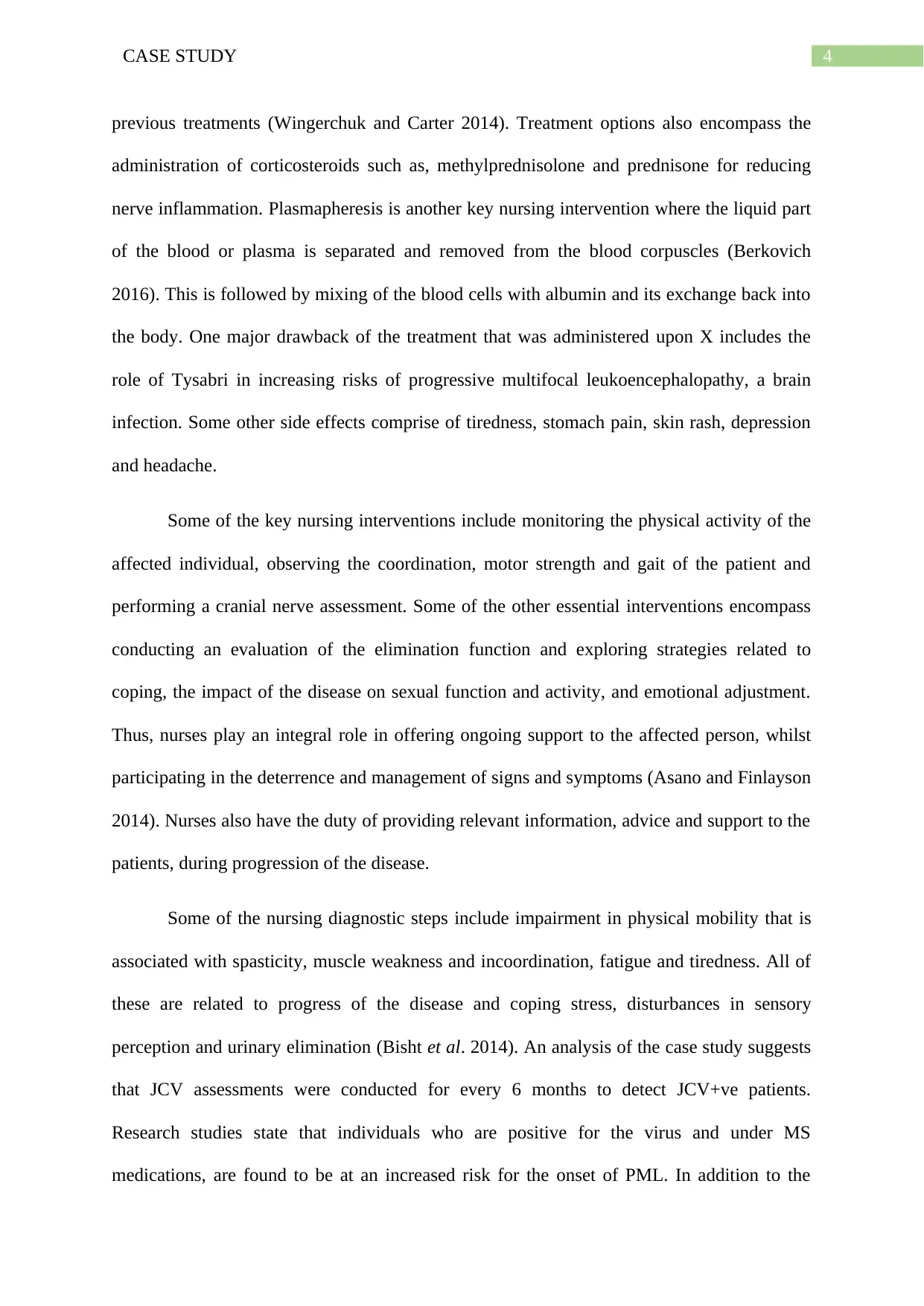
4CASE STUDY
previous treatments (Wingerchuk and Carter 2014). Treatment options also encompass the
administration of corticosteroids such as, methylprednisolone and prednisone for reducing
nerve inflammation. Plasmapheresis is another key nursing intervention where the liquid part
of the blood or plasma is separated and removed from the blood corpuscles (Berkovich
2016). This is followed by mixing of the blood cells with albumin and its exchange back into
the body. One major drawback of the treatment that was administered upon X includes the
role of Tysabri in increasing risks of progressive multifocal leukoencephalopathy, a brain
infection. Some other side effects comprise of tiredness, stomach pain, skin rash, depression
and headache.
Some of the key nursing interventions include monitoring the physical activity of the
affected individual, observing the coordination, motor strength and gait of the patient and
performing a cranial nerve assessment. Some of the other essential interventions encompass
conducting an evaluation of the elimination function and exploring strategies related to
coping, the impact of the disease on sexual function and activity, and emotional adjustment.
Thus, nurses play an integral role in offering ongoing support to the affected person, whilst
participating in the deterrence and management of signs and symptoms (Asano and Finlayson
2014). Nurses also have the duty of providing relevant information, advice and support to the
patients, during progression of the disease.
Some of the nursing diagnostic steps include impairment in physical mobility that is
associated with spasticity, muscle weakness and incoordination, fatigue and tiredness. All of
these are related to progress of the disease and coping stress, disturbances in sensory
perception and urinary elimination (Bisht et al. 2014). An analysis of the case study suggests
that JCV assessments were conducted for every 6 months to detect JCV+ve patients.
Research studies state that individuals who are positive for the virus and under MS
medications, are found to be at an increased risk for the onset of PML. In addition to the
previous treatments (Wingerchuk and Carter 2014). Treatment options also encompass the
administration of corticosteroids such as, methylprednisolone and prednisone for reducing
nerve inflammation. Plasmapheresis is another key nursing intervention where the liquid part
of the blood or plasma is separated and removed from the blood corpuscles (Berkovich
2016). This is followed by mixing of the blood cells with albumin and its exchange back into
the body. One major drawback of the treatment that was administered upon X includes the
role of Tysabri in increasing risks of progressive multifocal leukoencephalopathy, a brain
infection. Some other side effects comprise of tiredness, stomach pain, skin rash, depression
and headache.
Some of the key nursing interventions include monitoring the physical activity of the
affected individual, observing the coordination, motor strength and gait of the patient and
performing a cranial nerve assessment. Some of the other essential interventions encompass
conducting an evaluation of the elimination function and exploring strategies related to
coping, the impact of the disease on sexual function and activity, and emotional adjustment.
Thus, nurses play an integral role in offering ongoing support to the affected person, whilst
participating in the deterrence and management of signs and symptoms (Asano and Finlayson
2014). Nurses also have the duty of providing relevant information, advice and support to the
patients, during progression of the disease.
Some of the nursing diagnostic steps include impairment in physical mobility that is
associated with spasticity, muscle weakness and incoordination, fatigue and tiredness. All of
these are related to progress of the disease and coping stress, disturbances in sensory
perception and urinary elimination (Bisht et al. 2014). An analysis of the case study suggests
that JCV assessments were conducted for every 6 months to detect JCV+ve patients.
Research studies state that individuals who are positive for the virus and under MS
medications, are found to be at an increased risk for the onset of PML. In addition to the
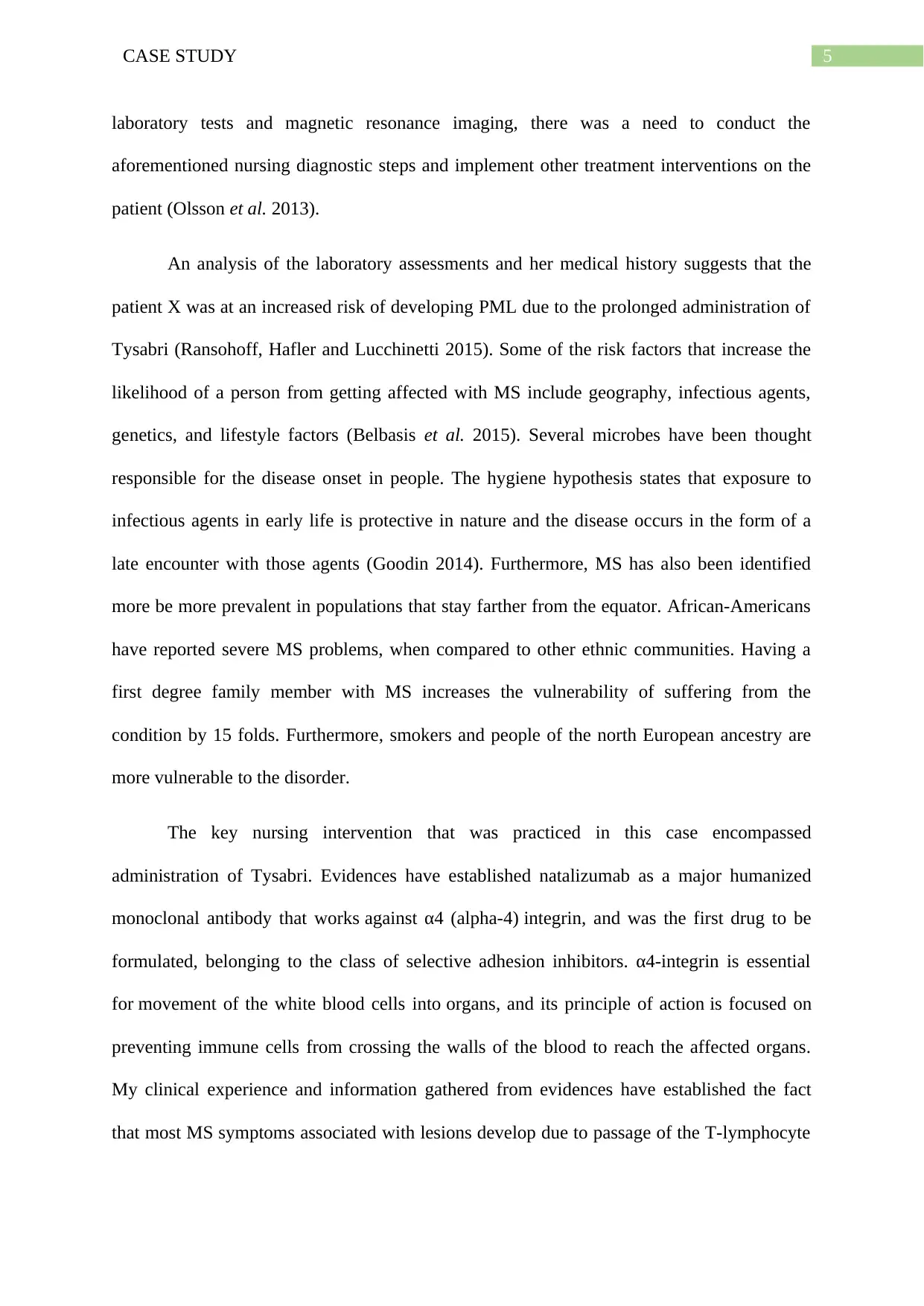
5CASE STUDY
laboratory tests and magnetic resonance imaging, there was a need to conduct the
aforementioned nursing diagnostic steps and implement other treatment interventions on the
patient (Olsson et al. 2013).
An analysis of the laboratory assessments and her medical history suggests that the
patient X was at an increased risk of developing PML due to the prolonged administration of
Tysabri (Ransohoff, Hafler and Lucchinetti 2015). Some of the risk factors that increase the
likelihood of a person from getting affected with MS include geography, infectious agents,
genetics, and lifestyle factors (Belbasis et al. 2015). Several microbes have been thought
responsible for the disease onset in people. The hygiene hypothesis states that exposure to
infectious agents in early life is protective in nature and the disease occurs in the form of a
late encounter with those agents (Goodin 2014). Furthermore, MS has also been identified
more be more prevalent in populations that stay farther from the equator. African-Americans
have reported severe MS problems, when compared to other ethnic communities. Having a
first degree family member with MS increases the vulnerability of suffering from the
condition by 15 folds. Furthermore, smokers and people of the north European ancestry are
more vulnerable to the disorder.
The key nursing intervention that was practiced in this case encompassed
administration of Tysabri. Evidences have established natalizumab as a major humanized
monoclonal antibody that works against α4 (alpha-4) integrin, and was the first drug to be
formulated, belonging to the class of selective adhesion inhibitors. α4-integrin is essential
for movement of the white blood cells into organs, and its principle of action is focused on
preventing immune cells from crossing the walls of the blood to reach the affected organs.
My clinical experience and information gathered from evidences have established the fact
that most MS symptoms associated with lesions develop due to passage of the T-lymphocyte
laboratory tests and magnetic resonance imaging, there was a need to conduct the
aforementioned nursing diagnostic steps and implement other treatment interventions on the
patient (Olsson et al. 2013).
An analysis of the laboratory assessments and her medical history suggests that the
patient X was at an increased risk of developing PML due to the prolonged administration of
Tysabri (Ransohoff, Hafler and Lucchinetti 2015). Some of the risk factors that increase the
likelihood of a person from getting affected with MS include geography, infectious agents,
genetics, and lifestyle factors (Belbasis et al. 2015). Several microbes have been thought
responsible for the disease onset in people. The hygiene hypothesis states that exposure to
infectious agents in early life is protective in nature and the disease occurs in the form of a
late encounter with those agents (Goodin 2014). Furthermore, MS has also been identified
more be more prevalent in populations that stay farther from the equator. African-Americans
have reported severe MS problems, when compared to other ethnic communities. Having a
first degree family member with MS increases the vulnerability of suffering from the
condition by 15 folds. Furthermore, smokers and people of the north European ancestry are
more vulnerable to the disorder.
The key nursing intervention that was practiced in this case encompassed
administration of Tysabri. Evidences have established natalizumab as a major humanized
monoclonal antibody that works against α4 (alpha-4) integrin, and was the first drug to be
formulated, belonging to the class of selective adhesion inhibitors. α4-integrin is essential
for movement of the white blood cells into organs, and its principle of action is focused on
preventing immune cells from crossing the walls of the blood to reach the affected organs.
My clinical experience and information gathered from evidences have established the fact
that most MS symptoms associated with lesions develop due to passage of the T-lymphocyte
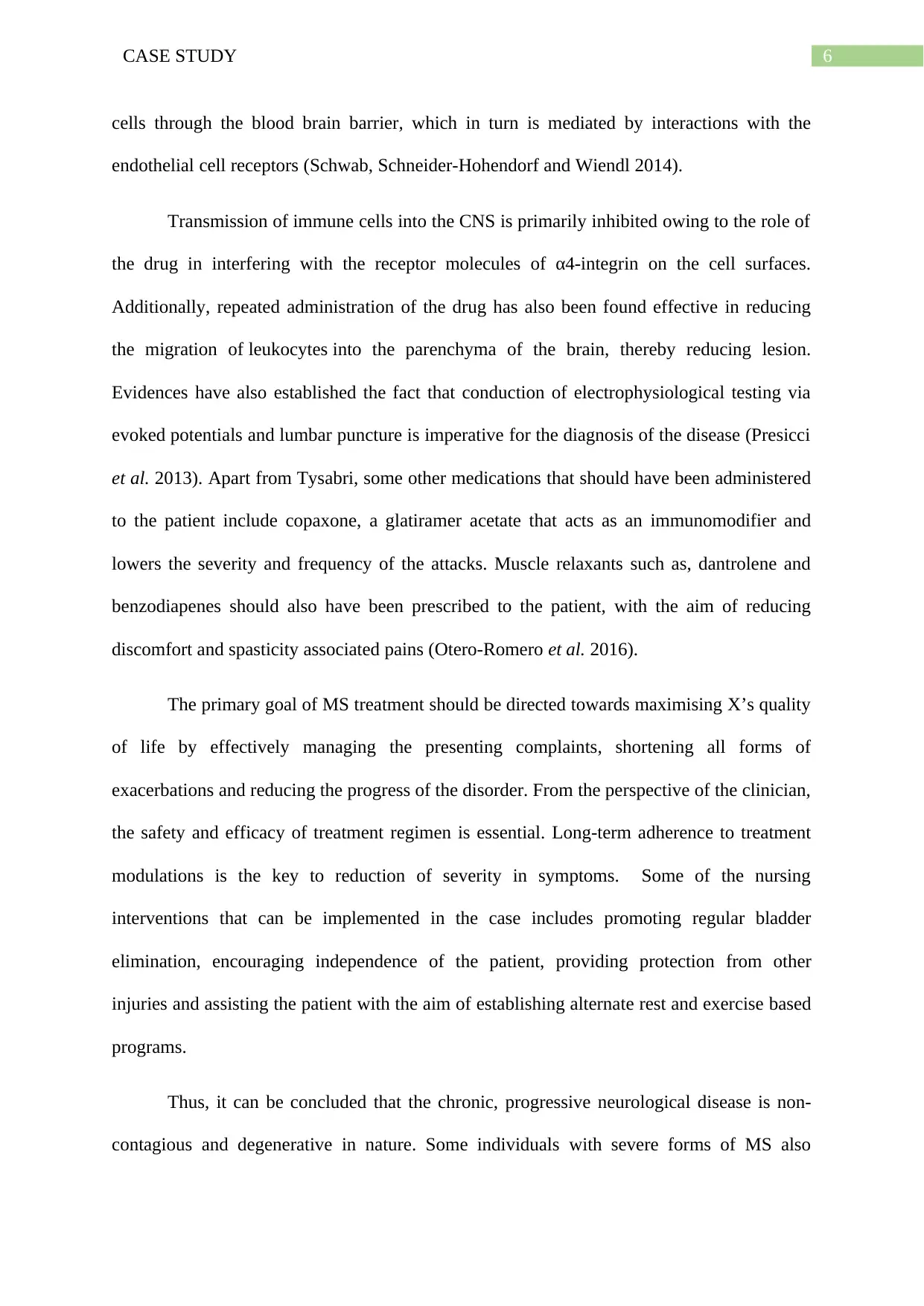
6CASE STUDY
cells through the blood brain barrier, which in turn is mediated by interactions with the
endothelial cell receptors (Schwab, Schneider-Hohendorf and Wiendl 2014).
Transmission of immune cells into the CNS is primarily inhibited owing to the role of
the drug in interfering with the receptor molecules of α4-integrin on the cell surfaces.
Additionally, repeated administration of the drug has also been found effective in reducing
the migration of leukocytes into the parenchyma of the brain, thereby reducing lesion.
Evidences have also established the fact that conduction of electrophysiological testing via
evoked potentials and lumbar puncture is imperative for the diagnosis of the disease (Presicci
et al. 2013). Apart from Tysabri, some other medications that should have been administered
to the patient include copaxone, a glatiramer acetate that acts as an immunomodifier and
lowers the severity and frequency of the attacks. Muscle relaxants such as, dantrolene and
benzodiapenes should also have been prescribed to the patient, with the aim of reducing
discomfort and spasticity associated pains (Otero-Romero et al. 2016).
The primary goal of MS treatment should be directed towards maximising X’s quality
of life by effectively managing the presenting complaints, shortening all forms of
exacerbations and reducing the progress of the disorder. From the perspective of the clinician,
the safety and efficacy of treatment regimen is essential. Long-term adherence to treatment
modulations is the key to reduction of severity in symptoms. Some of the nursing
interventions that can be implemented in the case includes promoting regular bladder
elimination, encouraging independence of the patient, providing protection from other
injuries and assisting the patient with the aim of establishing alternate rest and exercise based
programs.
Thus, it can be concluded that the chronic, progressive neurological disease is non-
contagious and degenerative in nature. Some individuals with severe forms of MS also
cells through the blood brain barrier, which in turn is mediated by interactions with the
endothelial cell receptors (Schwab, Schneider-Hohendorf and Wiendl 2014).
Transmission of immune cells into the CNS is primarily inhibited owing to the role of
the drug in interfering with the receptor molecules of α4-integrin on the cell surfaces.
Additionally, repeated administration of the drug has also been found effective in reducing
the migration of leukocytes into the parenchyma of the brain, thereby reducing lesion.
Evidences have also established the fact that conduction of electrophysiological testing via
evoked potentials and lumbar puncture is imperative for the diagnosis of the disease (Presicci
et al. 2013). Apart from Tysabri, some other medications that should have been administered
to the patient include copaxone, a glatiramer acetate that acts as an immunomodifier and
lowers the severity and frequency of the attacks. Muscle relaxants such as, dantrolene and
benzodiapenes should also have been prescribed to the patient, with the aim of reducing
discomfort and spasticity associated pains (Otero-Romero et al. 2016).
The primary goal of MS treatment should be directed towards maximising X’s quality
of life by effectively managing the presenting complaints, shortening all forms of
exacerbations and reducing the progress of the disorder. From the perspective of the clinician,
the safety and efficacy of treatment regimen is essential. Long-term adherence to treatment
modulations is the key to reduction of severity in symptoms. Some of the nursing
interventions that can be implemented in the case includes promoting regular bladder
elimination, encouraging independence of the patient, providing protection from other
injuries and assisting the patient with the aim of establishing alternate rest and exercise based
programs.
Thus, it can be concluded that the chronic, progressive neurological disease is non-
contagious and degenerative in nature. Some individuals with severe forms of MS also
Paraphrase This Document
Need a fresh take? Get an instant paraphrase of this document with our AI Paraphraser
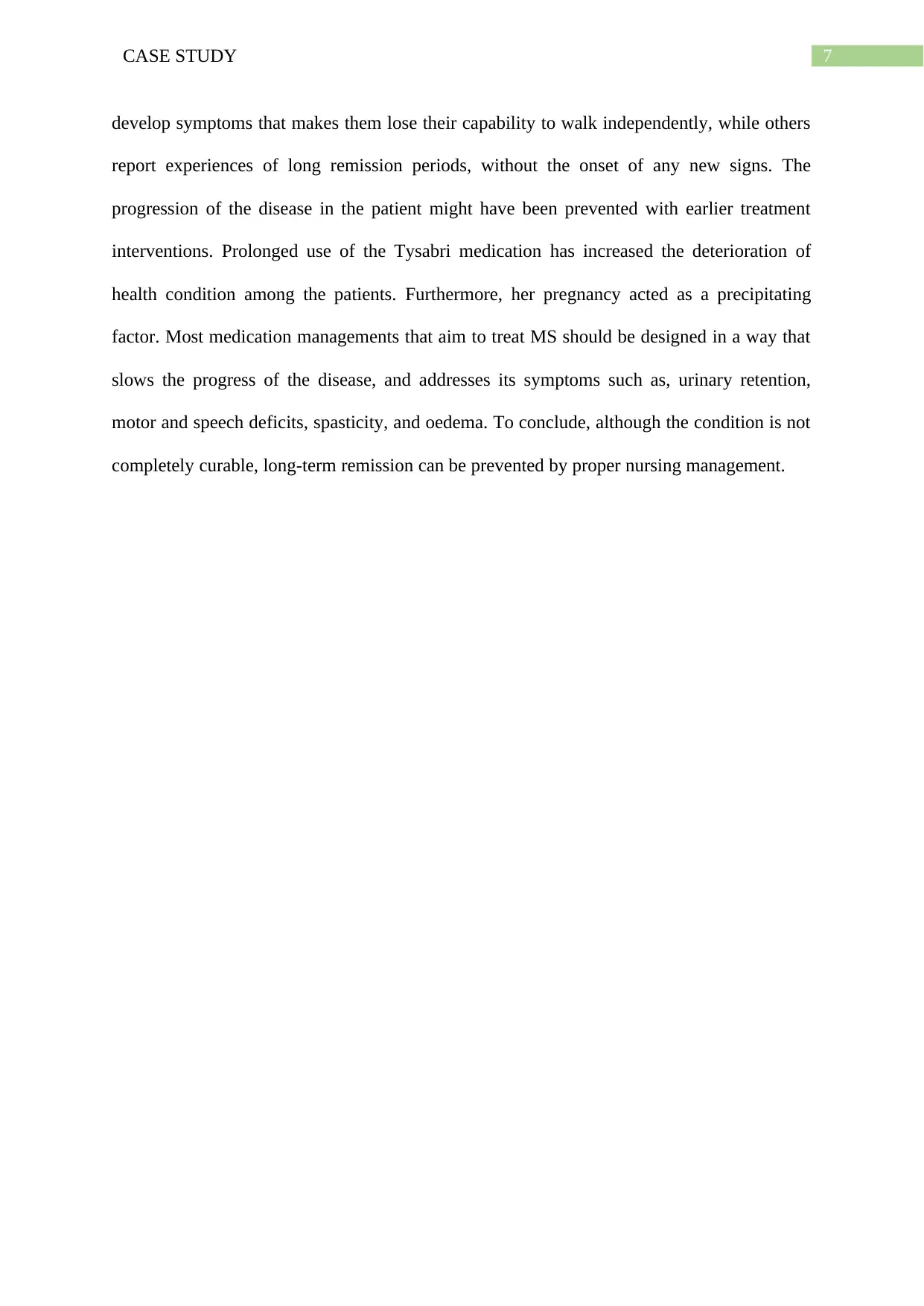
7CASE STUDY
develop symptoms that makes them lose their capability to walk independently, while others
report experiences of long remission periods, without the onset of any new signs. The
progression of the disease in the patient might have been prevented with earlier treatment
interventions. Prolonged use of the Tysabri medication has increased the deterioration of
health condition among the patients. Furthermore, her pregnancy acted as a precipitating
factor. Most medication managements that aim to treat MS should be designed in a way that
slows the progress of the disease, and addresses its symptoms such as, urinary retention,
motor and speech deficits, spasticity, and oedema. To conclude, although the condition is not
completely curable, long-term remission can be prevented by proper nursing management.
develop symptoms that makes them lose their capability to walk independently, while others
report experiences of long remission periods, without the onset of any new signs. The
progression of the disease in the patient might have been prevented with earlier treatment
interventions. Prolonged use of the Tysabri medication has increased the deterioration of
health condition among the patients. Furthermore, her pregnancy acted as a precipitating
factor. Most medication managements that aim to treat MS should be designed in a way that
slows the progress of the disease, and addresses its symptoms such as, urinary retention,
motor and speech deficits, spasticity, and oedema. To conclude, although the condition is not
completely curable, long-term remission can be prevented by proper nursing management.
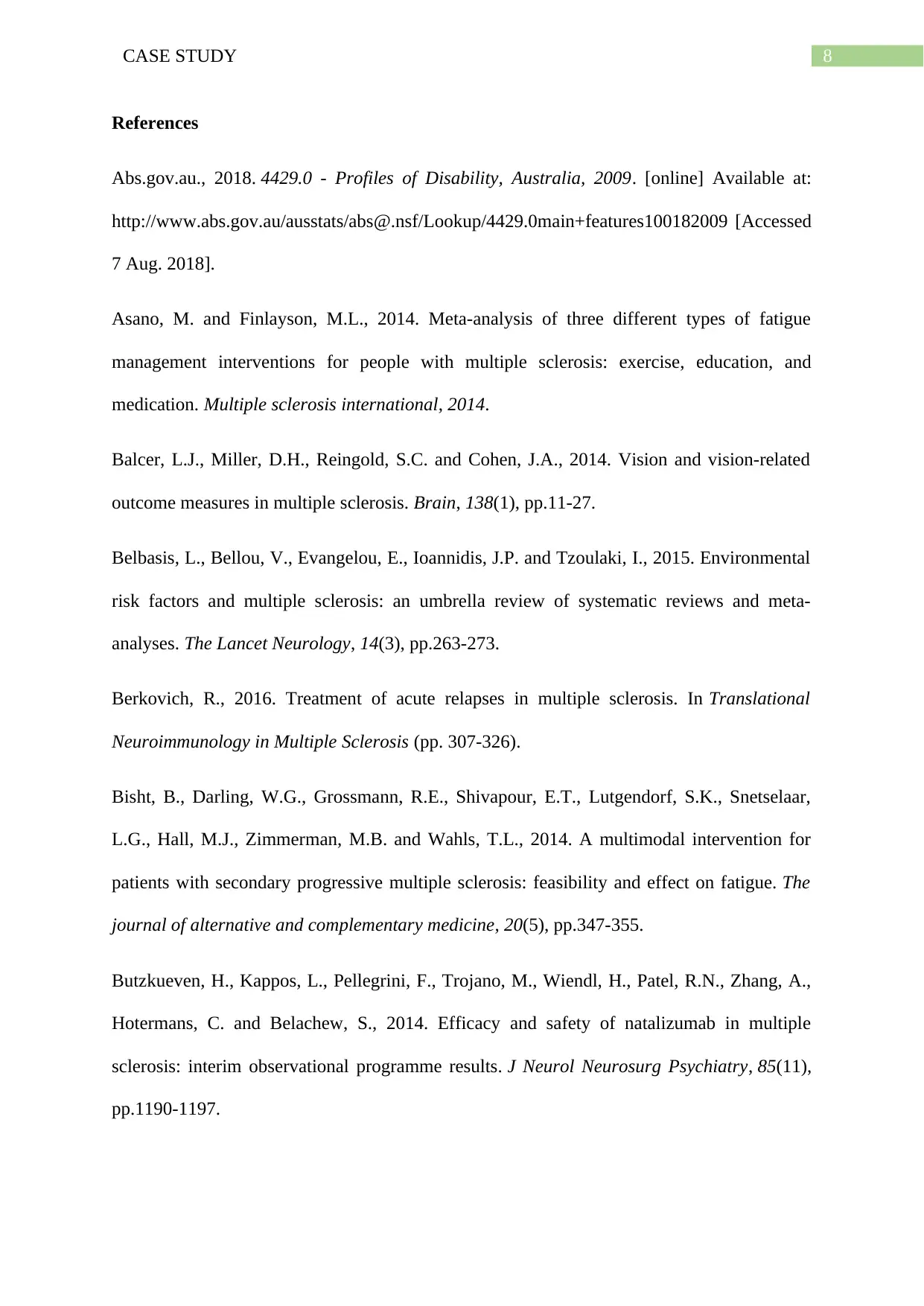
8CASE STUDY
References
Abs.gov.au., 2018. 4429.0 - Profiles of Disability, Australia, 2009. [online] Available at:
http://www.abs.gov.au/ausstats/abs@.nsf/Lookup/4429.0main+features100182009 [Accessed
7 Aug. 2018].
Asano, M. and Finlayson, M.L., 2014. Meta-analysis of three different types of fatigue
management interventions for people with multiple sclerosis: exercise, education, and
medication. Multiple sclerosis international, 2014.
Balcer, L.J., Miller, D.H., Reingold, S.C. and Cohen, J.A., 2014. Vision and vision-related
outcome measures in multiple sclerosis. Brain, 138(1), pp.11-27.
Belbasis, L., Bellou, V., Evangelou, E., Ioannidis, J.P. and Tzoulaki, I., 2015. Environmental
risk factors and multiple sclerosis: an umbrella review of systematic reviews and meta-
analyses. The Lancet Neurology, 14(3), pp.263-273.
Berkovich, R., 2016. Treatment of acute relapses in multiple sclerosis. In Translational
Neuroimmunology in Multiple Sclerosis (pp. 307-326).
Bisht, B., Darling, W.G., Grossmann, R.E., Shivapour, E.T., Lutgendorf, S.K., Snetselaar,
L.G., Hall, M.J., Zimmerman, M.B. and Wahls, T.L., 2014. A multimodal intervention for
patients with secondary progressive multiple sclerosis: feasibility and effect on fatigue. The
journal of alternative and complementary medicine, 20(5), pp.347-355.
Butzkueven, H., Kappos, L., Pellegrini, F., Trojano, M., Wiendl, H., Patel, R.N., Zhang, A.,
Hotermans, C. and Belachew, S., 2014. Efficacy and safety of natalizumab in multiple
sclerosis: interim observational programme results. J Neurol Neurosurg Psychiatry, 85(11),
pp.1190-1197.
References
Abs.gov.au., 2018. 4429.0 - Profiles of Disability, Australia, 2009. [online] Available at:
http://www.abs.gov.au/ausstats/abs@.nsf/Lookup/4429.0main+features100182009 [Accessed
7 Aug. 2018].
Asano, M. and Finlayson, M.L., 2014. Meta-analysis of three different types of fatigue
management interventions for people with multiple sclerosis: exercise, education, and
medication. Multiple sclerosis international, 2014.
Balcer, L.J., Miller, D.H., Reingold, S.C. and Cohen, J.A., 2014. Vision and vision-related
outcome measures in multiple sclerosis. Brain, 138(1), pp.11-27.
Belbasis, L., Bellou, V., Evangelou, E., Ioannidis, J.P. and Tzoulaki, I., 2015. Environmental
risk factors and multiple sclerosis: an umbrella review of systematic reviews and meta-
analyses. The Lancet Neurology, 14(3), pp.263-273.
Berkovich, R., 2016. Treatment of acute relapses in multiple sclerosis. In Translational
Neuroimmunology in Multiple Sclerosis (pp. 307-326).
Bisht, B., Darling, W.G., Grossmann, R.E., Shivapour, E.T., Lutgendorf, S.K., Snetselaar,
L.G., Hall, M.J., Zimmerman, M.B. and Wahls, T.L., 2014. A multimodal intervention for
patients with secondary progressive multiple sclerosis: feasibility and effect on fatigue. The
journal of alternative and complementary medicine, 20(5), pp.347-355.
Butzkueven, H., Kappos, L., Pellegrini, F., Trojano, M., Wiendl, H., Patel, R.N., Zhang, A.,
Hotermans, C. and Belachew, S., 2014. Efficacy and safety of natalizumab in multiple
sclerosis: interim observational programme results. J Neurol Neurosurg Psychiatry, 85(11),
pp.1190-1197.
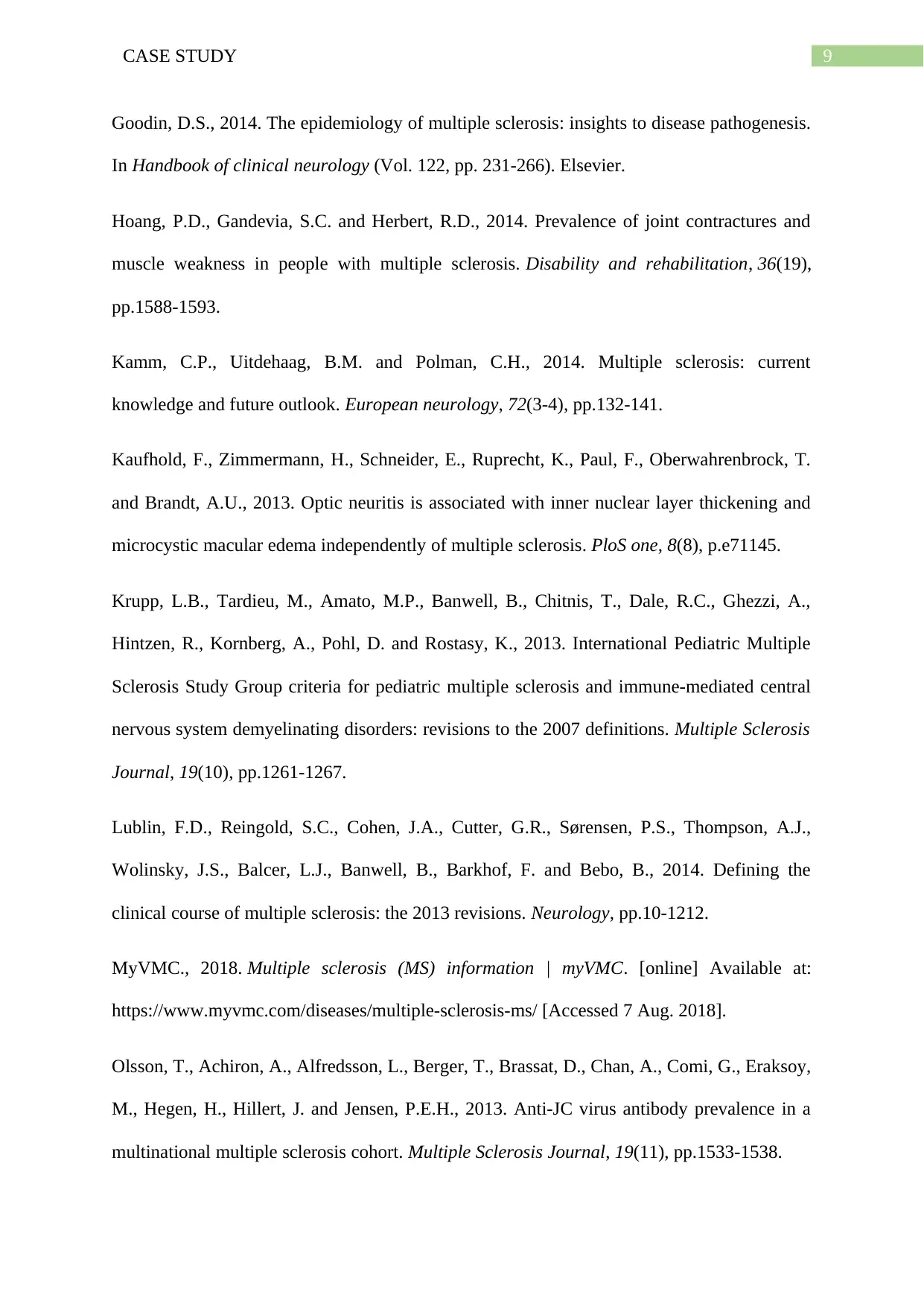
9CASE STUDY
Goodin, D.S., 2014. The epidemiology of multiple sclerosis: insights to disease pathogenesis.
In Handbook of clinical neurology (Vol. 122, pp. 231-266). Elsevier.
Hoang, P.D., Gandevia, S.C. and Herbert, R.D., 2014. Prevalence of joint contractures and
muscle weakness in people with multiple sclerosis. Disability and rehabilitation, 36(19),
pp.1588-1593.
Kamm, C.P., Uitdehaag, B.M. and Polman, C.H., 2014. Multiple sclerosis: current
knowledge and future outlook. European neurology, 72(3-4), pp.132-141.
Kaufhold, F., Zimmermann, H., Schneider, E., Ruprecht, K., Paul, F., Oberwahrenbrock, T.
and Brandt, A.U., 2013. Optic neuritis is associated with inner nuclear layer thickening and
microcystic macular edema independently of multiple sclerosis. PloS one, 8(8), p.e71145.
Krupp, L.B., Tardieu, M., Amato, M.P., Banwell, B., Chitnis, T., Dale, R.C., Ghezzi, A.,
Hintzen, R., Kornberg, A., Pohl, D. and Rostasy, K., 2013. International Pediatric Multiple
Sclerosis Study Group criteria for pediatric multiple sclerosis and immune-mediated central
nervous system demyelinating disorders: revisions to the 2007 definitions. Multiple Sclerosis
Journal, 19(10), pp.1261-1267.
Lublin, F.D., Reingold, S.C., Cohen, J.A., Cutter, G.R., Sørensen, P.S., Thompson, A.J.,
Wolinsky, J.S., Balcer, L.J., Banwell, B., Barkhof, F. and Bebo, B., 2014. Defining the
clinical course of multiple sclerosis: the 2013 revisions. Neurology, pp.10-1212.
MyVMC., 2018. Multiple sclerosis (MS) information | myVMC. [online] Available at:
https://www.myvmc.com/diseases/multiple-sclerosis-ms/ [Accessed 7 Aug. 2018].
Olsson, T., Achiron, A., Alfredsson, L., Berger, T., Brassat, D., Chan, A., Comi, G., Eraksoy,
M., Hegen, H., Hillert, J. and Jensen, P.E.H., 2013. Anti-JC virus antibody prevalence in a
multinational multiple sclerosis cohort. Multiple Sclerosis Journal, 19(11), pp.1533-1538.
Goodin, D.S., 2014. The epidemiology of multiple sclerosis: insights to disease pathogenesis.
In Handbook of clinical neurology (Vol. 122, pp. 231-266). Elsevier.
Hoang, P.D., Gandevia, S.C. and Herbert, R.D., 2014. Prevalence of joint contractures and
muscle weakness in people with multiple sclerosis. Disability and rehabilitation, 36(19),
pp.1588-1593.
Kamm, C.P., Uitdehaag, B.M. and Polman, C.H., 2014. Multiple sclerosis: current
knowledge and future outlook. European neurology, 72(3-4), pp.132-141.
Kaufhold, F., Zimmermann, H., Schneider, E., Ruprecht, K., Paul, F., Oberwahrenbrock, T.
and Brandt, A.U., 2013. Optic neuritis is associated with inner nuclear layer thickening and
microcystic macular edema independently of multiple sclerosis. PloS one, 8(8), p.e71145.
Krupp, L.B., Tardieu, M., Amato, M.P., Banwell, B., Chitnis, T., Dale, R.C., Ghezzi, A.,
Hintzen, R., Kornberg, A., Pohl, D. and Rostasy, K., 2013. International Pediatric Multiple
Sclerosis Study Group criteria for pediatric multiple sclerosis and immune-mediated central
nervous system demyelinating disorders: revisions to the 2007 definitions. Multiple Sclerosis
Journal, 19(10), pp.1261-1267.
Lublin, F.D., Reingold, S.C., Cohen, J.A., Cutter, G.R., Sørensen, P.S., Thompson, A.J.,
Wolinsky, J.S., Balcer, L.J., Banwell, B., Barkhof, F. and Bebo, B., 2014. Defining the
clinical course of multiple sclerosis: the 2013 revisions. Neurology, pp.10-1212.
MyVMC., 2018. Multiple sclerosis (MS) information | myVMC. [online] Available at:
https://www.myvmc.com/diseases/multiple-sclerosis-ms/ [Accessed 7 Aug. 2018].
Olsson, T., Achiron, A., Alfredsson, L., Berger, T., Brassat, D., Chan, A., Comi, G., Eraksoy,
M., Hegen, H., Hillert, J. and Jensen, P.E.H., 2013. Anti-JC virus antibody prevalence in a
multinational multiple sclerosis cohort. Multiple Sclerosis Journal, 19(11), pp.1533-1538.
Secure Best Marks with AI Grader
Need help grading? Try our AI Grader for instant feedback on your assignments.
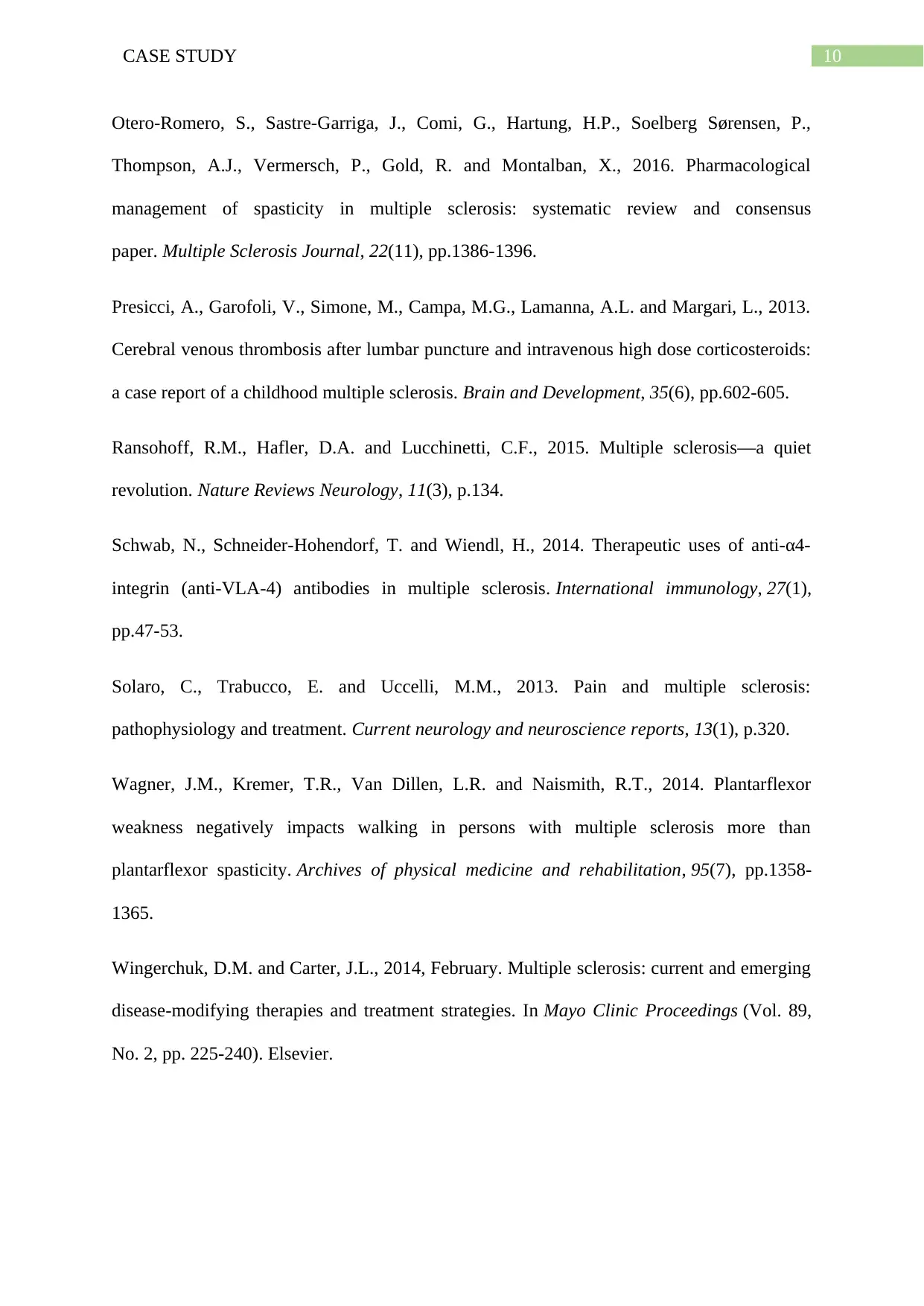
10CASE STUDY
Otero-Romero, S., Sastre-Garriga, J., Comi, G., Hartung, H.P., Soelberg Sørensen, P.,
Thompson, A.J., Vermersch, P., Gold, R. and Montalban, X., 2016. Pharmacological
management of spasticity in multiple sclerosis: systematic review and consensus
paper. Multiple Sclerosis Journal, 22(11), pp.1386-1396.
Presicci, A., Garofoli, V., Simone, M., Campa, M.G., Lamanna, A.L. and Margari, L., 2013.
Cerebral venous thrombosis after lumbar puncture and intravenous high dose corticosteroids:
a case report of a childhood multiple sclerosis. Brain and Development, 35(6), pp.602-605.
Ransohoff, R.M., Hafler, D.A. and Lucchinetti, C.F., 2015. Multiple sclerosis—a quiet
revolution. Nature Reviews Neurology, 11(3), p.134.
Schwab, N., Schneider-Hohendorf, T. and Wiendl, H., 2014. Therapeutic uses of anti-α4-
integrin (anti-VLA-4) antibodies in multiple sclerosis. International immunology, 27(1),
pp.47-53.
Solaro, C., Trabucco, E. and Uccelli, M.M., 2013. Pain and multiple sclerosis:
pathophysiology and treatment. Current neurology and neuroscience reports, 13(1), p.320.
Wagner, J.M., Kremer, T.R., Van Dillen, L.R. and Naismith, R.T., 2014. Plantarflexor
weakness negatively impacts walking in persons with multiple sclerosis more than
plantarflexor spasticity. Archives of physical medicine and rehabilitation, 95(7), pp.1358-
1365.
Wingerchuk, D.M. and Carter, J.L., 2014, February. Multiple sclerosis: current and emerging
disease-modifying therapies and treatment strategies. In Mayo Clinic Proceedings (Vol. 89,
No. 2, pp. 225-240). Elsevier.
Otero-Romero, S., Sastre-Garriga, J., Comi, G., Hartung, H.P., Soelberg Sørensen, P.,
Thompson, A.J., Vermersch, P., Gold, R. and Montalban, X., 2016. Pharmacological
management of spasticity in multiple sclerosis: systematic review and consensus
paper. Multiple Sclerosis Journal, 22(11), pp.1386-1396.
Presicci, A., Garofoli, V., Simone, M., Campa, M.G., Lamanna, A.L. and Margari, L., 2013.
Cerebral venous thrombosis after lumbar puncture and intravenous high dose corticosteroids:
a case report of a childhood multiple sclerosis. Brain and Development, 35(6), pp.602-605.
Ransohoff, R.M., Hafler, D.A. and Lucchinetti, C.F., 2015. Multiple sclerosis—a quiet
revolution. Nature Reviews Neurology, 11(3), p.134.
Schwab, N., Schneider-Hohendorf, T. and Wiendl, H., 2014. Therapeutic uses of anti-α4-
integrin (anti-VLA-4) antibodies in multiple sclerosis. International immunology, 27(1),
pp.47-53.
Solaro, C., Trabucco, E. and Uccelli, M.M., 2013. Pain and multiple sclerosis:
pathophysiology and treatment. Current neurology and neuroscience reports, 13(1), p.320.
Wagner, J.M., Kremer, T.R., Van Dillen, L.R. and Naismith, R.T., 2014. Plantarflexor
weakness negatively impacts walking in persons with multiple sclerosis more than
plantarflexor spasticity. Archives of physical medicine and rehabilitation, 95(7), pp.1358-
1365.
Wingerchuk, D.M. and Carter, J.L., 2014, February. Multiple sclerosis: current and emerging
disease-modifying therapies and treatment strategies. In Mayo Clinic Proceedings (Vol. 89,
No. 2, pp. 225-240). Elsevier.
1 out of 11
Related Documents
Your All-in-One AI-Powered Toolkit for Academic Success.
+13062052269
info@desklib.com
Available 24*7 on WhatsApp / Email
![[object Object]](/_next/static/media/star-bottom.7253800d.svg)
Unlock your academic potential
© 2024 | Zucol Services PVT LTD | All rights reserved.





